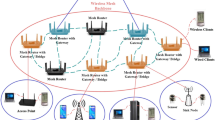Abstract
As wireless networks continue to see rapid growth, the next generation of networks needs to be designed to optimize fundamental capacity limits suggested by Shannon’s Information Theory. The use of simple coverage models and linear objective functions based on number of users will not provide optimal performance. This manuscript describes an optimization model and software tools that may be used to assist a network engineer in the design of a wireless local area network. The model uses Shannon’s channel capacity formula to calculate network capacity and is restricted to a single frequency with known locations for the mobile devices. Even under these assumptions, the model involves a complex nonlinear objective function with quadratic constraints. Multiple commercial software tools as well as a global optimizer developed by us are empirically evaluated on a set of test cases. One of the global solvers developed by LINDO Systems was found to work very well for all of the design cases tested.




Similar content being viewed by others
References
Adickes, M., Billo, R., Norman, B., Nnaji, B., & Rajgopal, J. (2002). Optimization of indoor wireless communication network layouts. IIE Transactions, 34, 823–826.
Amaldi, E., Bosio, S., Malucelli, F., & Yuan, D. (2011). Solving nonlinear covering problems arising in WLAN design. Operations Research, 59, 173–187.
Bahri, A., & Chamberland, S. (2005). On the wireless local area network design problem with performance guarantees. Computer Networks, 48, 856–866.
Fortune, S., Gay, D., Kerninghan, B., Landron, O., Valenzuela, R., & Wright, M. (1995). WISE design of indoor wireless systems: practical computation and optimization. IEEE Computational Science & Engineering, 2, 58–68.
Geier, J. (2009). 802.11a/b Site survey: a testimonial. Retrieved on August 13, 2009 at http://www.wi-fiplanet.com/columns/article.php/1479831.
Hills, A. (2001). Large-scale wireless LAN design. IEEE Communications Magazine, 39, 98–104.
Kennington, J., Kratz, J., & Spiride, G. (2010). Optimization based WLAN modeling and design, Chap. 6. In J. Kennington, E. Olinick, & D. Rajan (Eds.), Wireless network design: optimization models and solution procedures. New York: Springer.
Kennington, J., Kratz, J., & Rajan, D. (2010). The static wireless local area design problem (Technical Report 10-EMIS-05). Department of Engineering Management, Information, and Systems, Dallas, TX 75205, http://lyle.smu.edu/~jlk/10-EMIS-05/static.pdf.
Longo, F. (2009). WLAN design solution. Retrieved on July 15, 2009 at http://www.virtualacquisitionshowcase.com/docs/2007/OPNET-Brief.pdf.
Mateus, G., Loureiro, A., & Rodrigues, R. (2001). Optimal network design for wireless local area network. Annals of Operations Research, 106, 331–345.
Panjawni, M., Abbott, A., & Rappaport, T. (1996). Interactive computation of coverage regions for wireless indoor environments. IEEE Journal on Selected Areas in Communications, 14, 420–430.
Pinter, J. (1996). Global optimization in action: continuous and Lipschitz optimization—algorithms, implementations, and applications. Boston: Kluwer Academic.
Rappaport, T. (2002). Wireless communications: principles and practices. Delhi: Pearson Education (Singapore) Pte. Ltd., Indian Branch.
Rodrigues, R., Mateus, G., & Loureiro, A. (2000). On the design and capacity planning of a wireless local area network. In Network operations and management symposium (pp. 335–348).
Sherali, H., Pendyala, C., & Rappaport, T. (1996). Optimal location of transmitters for micro-cellular radio communication system design. IEEE Journal on Selected Areas in Communications, 14, 662–673.
Skidmore, R., Verstak, A., Ramakrishnan, N., Rappaport, T., Watson, L., He, J., Varadarajan, S., Shaffer, C., Chen, J., Bae, K., Jiang, J., & Tranter, W. (2004). Towards integrated PSEs for wireless communications: experiences with the S4W and SitePlanner® projects. Mobile Computing and Communications Review, 8, 20–34.
Acknowledgements
This research was supported in part by the Office of Naval Research under Award N00014-10-1-0330.
Author information
Authors and Affiliations
Corresponding author
Appendix: Derivation of attenuation formula
Appendix: Derivation of attenuation formula
Several equations are required to determine the attenuation between a pair of locations. The path-loss is the signal attenuation given in dB, and is defined as the difference between the transmitted power at the source location and the received power at the destination location. Path-loss is given in Rappaport [13] on p. 108, by
where P t is the transmitted power, and P r is the received power.
This equation can be rewritten as
Path loss can also be calculated directly between a pair of locations, given in Rappaport [13] on p. 161, by
where PL 0 is the known path-loss between locations at a distance of d 0, d is the distance between the source and destination location, n is a constant determined by the medium of transfer, and X σ is a random variable representing noise. For this analysis we use the expected value of X σ , which is 0. The noise associated with MD m, N m , used in this investigation is the root mean squared value of X σ and is generally assumed to have a value of 10−10.
Rappaport [13] gives n as 3.27 on p. 165, and we will use that number. Rappaport also gives a value for PL 0 for a d 0 of 1 meter, which we will denote as PL m . This value can be calculated from p. 166, giving a value for PL m of 31.5 dB. As we are working in feet, we had to convert this value into the PL f at 1 ft. As a meter is 3.28 feet:
Therefore, the PL at d ft from the source is given by
Rights and permissions
About this article
Cite this article
Kennington, J.L., Kratz, T.J. & Rajan, D. A WLAN design problem with known mobile device locations: a global optimization approach. Telecommun Syst 53, 227–238 (2013). https://doi.org/10.1007/s11235-013-9691-4
Published:
Issue Date:
DOI: https://doi.org/10.1007/s11235-013-9691-4




